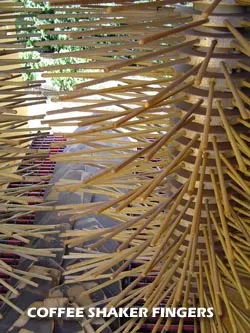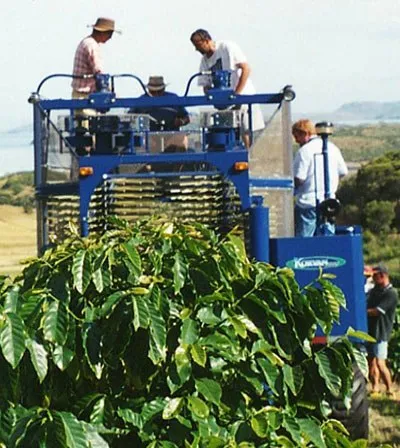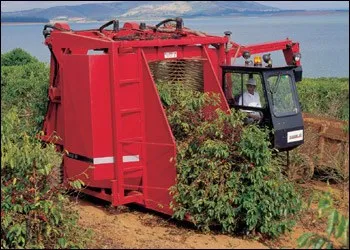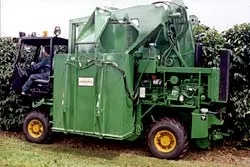Coffee has now been mechanically harvested for over 20 years, and while there are a few different brands of machines they are all basically the same design with the same components.
Nearly all harvesters have a diesel motor, which drives a large hydraulic pump. This pump then drives the hydraulic rams and many smaller hydraulic motors all over the harvester, and they run the conveyers, shakers, cleaning fans, height adjustment, steering and wheel drives. This system of hydraulics works well because the motors are robust, weather resistant, variable in speed and can have a very high torque rating.

Mechanical harvesters straddle the tree row [the tree goes inside them]; they have heavy counterweights on top of two columns, which are driven at variable speeds. As these weights spin they cause the columns to rotate. Attached to the columns are hundreds of picking rods, which vibrate and oscillate as the weights on top rotate.
The vibration of these rods through the trees is what picks the coffee off the tree. Below the columns are “fish plates” which are angled segments of polycarbonate sheet attached to springs. These fish plates fill the gaps between the tree trunks, and because of their angle the coffee cherries are rolled to the internal horizontal conveyers, which lead to other conveyers and finally to the holding bin.
There are two main brands of coffee harvesters: the Brastoft (formerly Austoft) and the Korvan. Both machines are basically the same in shape and size, but a couple of differences between the two machines have a major impact on the quality and quantity of cherry harvested.
The Korvan is driven from the top centre of the machine, which makes it very easy to drive down the tree row because the trees are straight below the operator. It also has a very powerful and variable speed cleaner fan system, which can remove all rubbish, and even the small-extended tree ripened coffee [ETRC]. These two points are its major advantages over the Brastoft harvester.
The Brastoft is driven at tree level on the left side of the tree row, which can make it hard to drive down the tree row and keep the trunks in the exact centre of the machine, especially when the trees are overgrown or not planted exactly in a straight line. But the big advantage of being at the tree level is that the driver can evaluate the amount of ripe vs unripe cherry on each tree and adjust the shaker speed (amount harvested) for each tree. This is not possible with the Korvan as the driver looks onto the top of the trees being harvested.
The Brastoft also has a variable motor driven retard coupling on the shaker system which can be adjusted from the driver’s cabin. This retard system stops the columns from turning rapidly when the shaker weights are running at high speeds, or even if no trees are within the picking fingers.

Korvan Harvester
This creates an increased oscillation through the picking rods and seems to create a more selective but stronger shake of the tree. The Korvan does not have this system but relies on friction straps that pull against the columns; these are adjusted by hand tools and are time consuming and a nuisance to adjust.
A major improvement that can be made to the Brastoft harvester is to remove the picking rod holders and fit Korvan holders to it. This is advantageous because the Korvan rod holders are much more durable and retain the rods longer, but the major benefit is that the picking fingers can be longer than either the original Brastoft or Korvan fingers.
This occurs because the Brastoft is wider column-to-column, and the Korvan rod holders are smaller in diameter than the Brastoft. With these longer picking fingers the harvester is even more selective in the ratio of ripe vs. unripe coffee harvested.

Brastoft Harvester
The conveyer system on the Korvan is gentler to the picked cherry but more susceptible to damage or stopping because the upright and top conveyers are made from plastic.
Both harvesters have a bin, which can hold approximately 1 tonne of cherry. The Brastoft has a bin, which has two small openings on the bottom, and this makes it easy to fill standard sized field bins that are easily transported by a regular tractor; whereas the Korvan bin unloads by lifting and tipping over, and as it’s quite long you either need a Korvan trailer, two field bins side by side, or you can modify the top of the bin into a funnel to unload the product. Both harvesters also have an over the row conveyer so that a tractor with a trailer can drive in the next row and the product is dropped into this trailer.
Overall both harvesters do a very good job. Personally I have achieved better results regarding quality [over 90 % ripe] with the modified Brastoft harvester, but different locations and different harvesting schedules could quite easily make the Korvan the preferred harvester.
